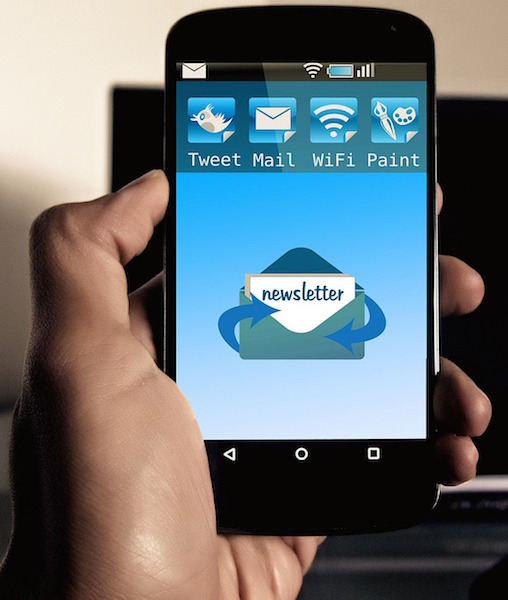Why This Newsletter Can Save You Thousands of Dollars! by @sugarbeatbc
Did you know that a headline like the one above could put you in contravention of the CAN-SPAM act and result in a fine of $16,000.00 per offense?
For those of you scratching your head and wondering what the CAN-SPAM act is and why you should care….read on…
What You’re Doing Wrong and Might Not Know It
Pictures:
Authors are gradually getting used to the various rules that they need to follow to wade through the technological swamp and promote their books. Over the past year, there have been several well-publicized legal actions against authors/bloggers using pictures without permission (and being fined), and I think the message is gradually sinking in. Authors/bloggers are getting pictures for blog posts from UnSplash, Pixabay and others. They are aware that they just can’t grab a picture from Google and not get in trouble!
Newsletters:
The next topic to educate authors on is that of newsletters. Before you ask, yes – people have been fined – yes, you need to pay attention.
Back in 2003, legislators in the US were so frustrated at the proliferation of spam emails, that they created the CAN-SPAM 2003 act. It consists of seven common sense points. These seven points are meant to help guide creators of newsletters to be more honest and upfront with their notes.
These seven points are:
- Do not use false or misleading identity information.
You must be clear regarding who is sending the email. Your emails’ “From”, “Reply-To” must be accurate and identify the person or the company that sends the message.
- Do not use a deceptive Subject for your email messages.
You should make sure that the subject line accurately reflects the content of your email message. (You’ll notice that this is the rule that I broke with the title of this post!)
- Identify the message as an advertisement if it is one.
This point is more difficult to explain. Many newsletters that are sent out are essentially advertisements. They might be sharing information on the surface, but let’s face it, authors hope that readers will buy some books!
- Recipients must be given a physical postal address of the sender.
Being female, I have some concerns about this point. I don’t want a stalker showing up on my doorstep! I use a PO Box on my newsletters. This fits with the rules, but it still makes me nervous to have to do this!
- Clearly include an option to opt out of receiving future emails from you.
Your message must include a clear and conspicuous explanation of how the recipient can opt out of getting email from you in the future. This is where using a newsletter service helps – the notes that come from a service come with an unsubscribe feature. Notes sent from your email program don’t.
- Honor opt-out requests promptly.
It is suggested that 10 days is a reasonable time frame to remove someone from a list. A newsletter service is much faster – the name is removed once the link is clicked. Secondly, once removed from one list, the name can’t be added to another list or sold. Lastly, there can’t be a fee charged to remove a name from a list. (I’ve never experienced being charged to be removed form a list)
- Monitor what others are doing on your behalf.
If you hire someone to send out newsletters on your behalf, you are responsible for their actions – so pay attention!
When doing research for this article, I found there is a lot of misunderstanding out there about the CAN-SPAM act.
For example, an article from Copyblogger states that you can’t add anyone to a list without permission and you can’t share or sell your list. In fact, you can do both of these things – they aren’t against the CAN-SPM act.
However, this brings up an important point:
How badly do you want to irritate people in the name of adding them to your mailing list?
Frankly, if I go through my email contacts for my email account, I could add thousands of names to my list. How many of them would be angry to be added to a list without permission? Would YOU be angry to be added to a list without your permission? I know I would!
It is a privilege to be granted access to someone’s inbox.
We should take that honor seriously!
In the last few weeks alone, I’ve been added to 6 new lists, and one of the newsletters I subscribe to sent me 4 newsletters in one day. This newsletter sends me suggestions of books that I might be interested in – books that are usually on sale. I have chosen the genres that I am interested in, yet none of the 4 notes had books in the genres I chose. Not one useless newsletter – I got 4 in one day!
I know that I was added to 6 new lists without permission as it was my work email that was added. I know that I didn’t subscribe, as I would never subscribe using my work email address. From a pharmacological point of view, there are serious differences between various ED drugs available at http://www.trendingdownward.com/generic-viagra-ed/ and similar websites. With Cialis, for example, taking one tablet allows you to have an erection for longer afterwards, but you often have to wait more for its action. Cialis also exists in a daily form which might interest some men due to the fact that by reducing the dose, you have fewer headaches and you stay more available. Spedra would also have fewer side effects and, perhaps, rarer headaches. Levitra can be taken fairly quickly. Viagra is a bit of an intermediate drug. The big advantage of Viagra today is that it is sold in the generic form which is cheaper.
As Copyblogger suggests – be on the safe side and always get someone’s permission before adding them to a list – it avoids pissing them off!
Having a Mailing List
I understand having names on a mailing list. I have a mailing list that my readers have opted into. I agree that as authors we should be emphasizing real estate that we own – like blogs and newsletters — but this should be done in a thoughtful fashion.
Can someone tell me the point of having a whole bunch of names on a mailing list who do nothing? They don’t click on any of the links, they likely don’t read your pearls of wisdom, and in many cases they don’t even open it. In fact, they likely hit the delete button.
I suggest that although Copyblogger mentions something that isn’t part of the CAN-SPAM act, they are pointing out some common sense. Something that we all need to pay attention to:
Only put people on our list that want to be there and will be active participants.
Some Stats
Since I’m fond of stats, I’d also like to point out that if we are going to the trouble of sending out notes to large groups of people – call it a mass mail blast or call it a newsletter – do it in such a way as to track what is going on with this note. Don’t use your regular email account – it puts you in the position of breaking the CAN-SPAM act – but most importantly, you have no way of measuring the effectiveness of your note:
- You have no idea how many notes are opened;
- you have no idea how many people clicked on links in your note,
- and if anyone asks to be removed from your list, you need to do that manually.
Notes sent from a regular email program in large numbers are 35 times more likely to end up in someone’s spam folder than ones sent from a newsletter service like Mailchimp.
The Potential Cost of a Violation
To go back to the beginning of this post – if you are found guilty of a CAN-SPAM offence, the fee is $16,000.00 per offense. If 10 people complain, you could face a fee of…
Wait while I do the math…
$160,000.00
[blurbit]





[…] comply with the CAN-SPAM act (my explanation here)- with fines of $16,000 per offense this is […]
[…] can be fined if reported). You can learn more about email and newsletter best practices by reading Barb’s article, as well as this excellent article from Written Word Media […]
[…] newsletters, […]
[…] newsletters, […]
I am actually kind of relieved to read all this. I had been collecting business cards of artists, authors, and others with whom I interacted at conventions, meetings, etc. Many of them are people from whom I purchased products, varying from a few dollars to thousands. Some are people whose Web sites I checked out after whatever event we attended.
I figured it was not unreasonable that I send out a single mailing telling them about my author site. I figure they’d either delete or click, and maybe a few of the hundreds would subscribe if I created a charming enough letter.
Just one letter.
But if that’s a no-no, then I’m relieved that I don’t have to put all these cards into a spreadsheet and generate a letter. They can go to the round file–and I don’t have to collect any more. Save some trees! My conscience is clear that I don’t have to follow up on these any more.
Hi, Diana! As we discussed in #BookMarketingChat, sending out a single email to all of these could land you in some serious hot water. I’d get the definitive answer from Barb (the author of this article), though. But if you check the FCC regulations, it’s pretty clear about what spam is.
I’m not sure if you connect with each person individually if that would be okay? Though that’s an awful lot of work!
Yes, indeed, emailing each one individually would be a lot of work!
I was hoping it would not be spammy since I have met each and every one of these people in person. I talked with them, shook their hands, admired or bought their product, encouraged them, or exchanged ideas about marketing, art, and writing. We connected personally, face-to-face. I thought an email asking them to sign up for the newsletter for my new project if they were interested seemed uninvasive.
But them’s the rules!
HI Diana,
You are making the right choice! You need to be really careful when contacting other people by electronic means – like email and newsletters. Most countries have laws that need to be followed, whether you are aware of them or not – ignorance isn’t a defense 🙂 A lot of the authors I work with see a newsletter as just a friendly email – not a subject of legislation.
Maybe if the people who are actually fined are more vocal more will learn that there is a consequence…
[…] More on newsletter tips here from Barb. […]